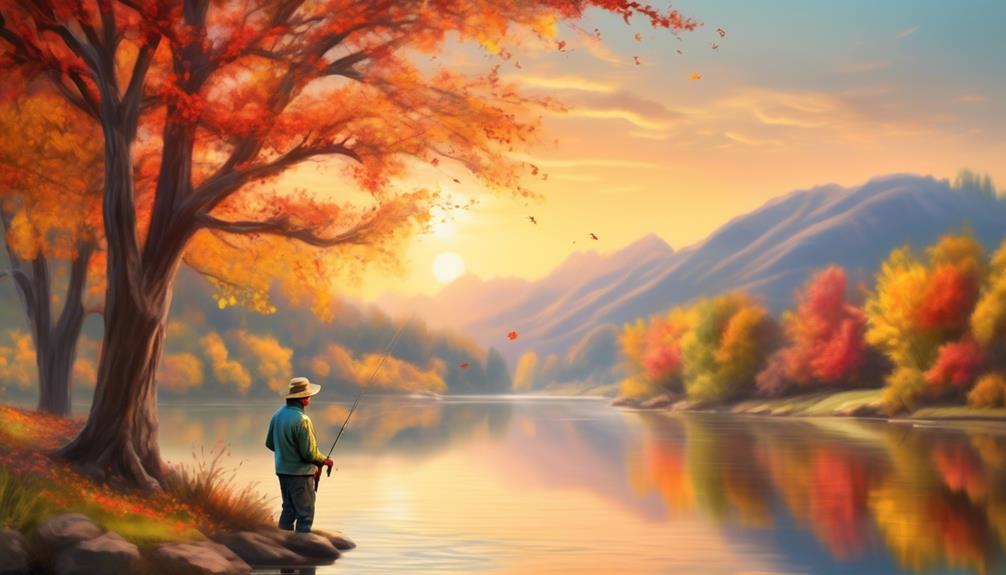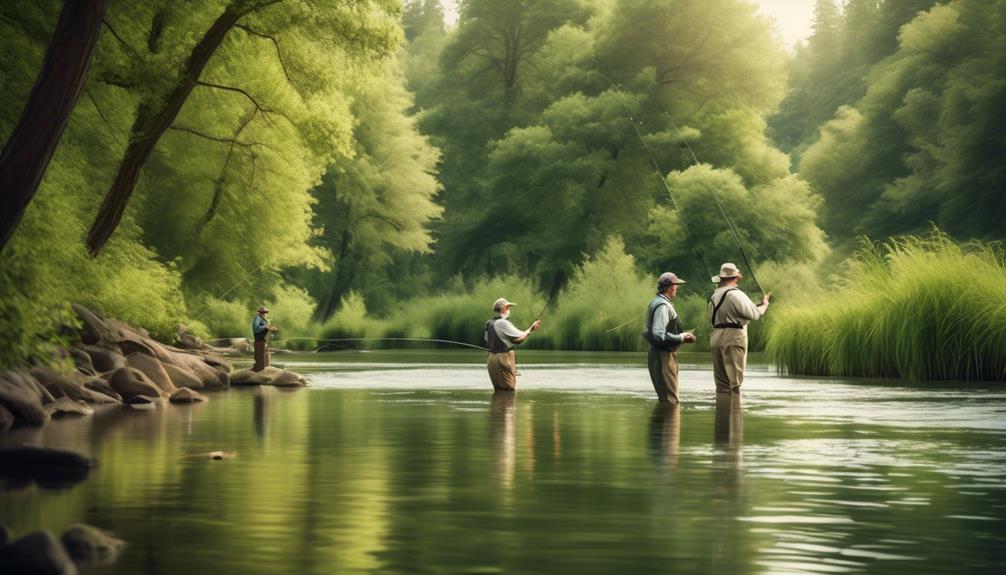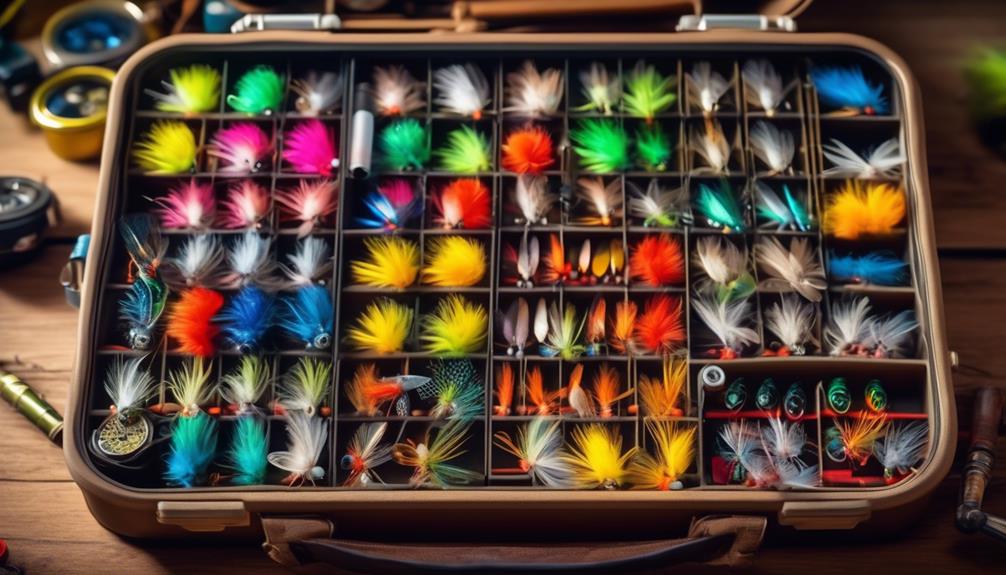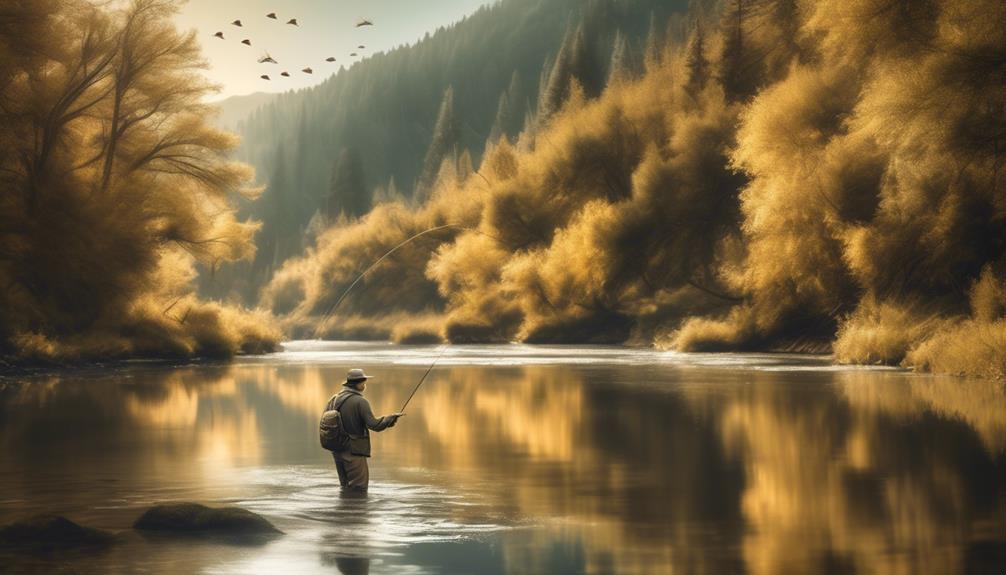When it comes to fly fishing, did you know that the prime season for optimal experience is not limited to just one time of the year?
Each season offers its own unique opportunities for successful fly fishing. From the rejuvenation of spring to the vibrant colors of fall, there are specific factors that make each season ideal for this outdoor activity.
Whether you're a seasoned angler or just starting out, understanding the nuances of each season can greatly enhance your fly fishing experience.
Springtime Fly Fishing
Springtime is the ideal season for fly fishing as the water warms, the insects begin to hatch, and the fish become more active. It's the perfect time to take advantage of the trout feeding frenzy. As the temperatures rise, the aquatic environment comes to life, and the fish start actively looking for food. This is when using the right nymph patterns can greatly enhance your chances of a successful catch.
Trout are known to be particularly active during the spring months as they seek out nymphs and other aquatic insects. This makes it an excellent time for fly fishing enthusiasts to capitalize on the trout's feeding patterns. Using nymph patterns that imitate the insects hatching in the spring can yield great results. Patterns such as the Pheasant Tail Nymph, Hare's Ear Nymph, and Copper John are highly effective during this time of the year.
When fly fishing in the spring, it's important to understand the behavior of the trout and the types of insects they're feeding on. By observing the water and understanding the hatch patterns, you can choose the appropriate nymph patterns to entice the trout. Remember to present your flies naturally and drift them along the current to mimic the movement of the real insects.
With the right approach and the proper use of nymph patterns, you can make the most of the trout feeding activity during the springtime.
Summer Fly Fishing
As the temperatures continue to rise and the aquatic environment remains vibrant, you'll find that summer fly fishing offers its own set of exciting opportunities for anglers. During the summer months, rivers are typically at their lowest flow rates, providing clearer water and more accessible wading areas. This creates ideal conditions for fly fishing, as fish are more visible and active in pursuit of food.
However, the summer heat can also pose challenges, so it's essential to consider river conditions and gear selection to make the most of your fishing experience.
- River conditions: In summer, rivers tend to run lower and clearer, making it easier to spot fish and presenting opportunities for dry fly fishing. However, higher water temperatures can lead to decreased oxygen levels, causing fish to seek cooler, deeper pools. When planning a summer fly fishing trip, be mindful of the river's water temperature and potential regulations for catch-and-release to protect fish during warmer periods.
- Gear selection: With the sun beating down, it's crucial to have appropriate gear for summer fly fishing. Consider using lighter weight rods and lines to make casting more comfortable during the hotter days. Additionally, wearing breathable clothing and using sunscreen are essential for staying protected and comfortable while out on the water.
Fall Fly Fishing
Get ready to experience the exhilarating opportunities that fall fly fishing brings as the temperatures begin to cool and nature transitions into its autumnal splendor.
Fall is a fantastic time for fly fishing, offering serene landscapes and excellent angling opportunities. When it comes to the best locations for fall fly fishing, look no further than rivers and streams that host spawning runs of various fish species. Some top locations include the Madison River in Montana, the Bighorn River in Wyoming, and the Kenai River in Alaska. These rivers offer stunning backdrops of changing foliage and an abundance of fish, making them ideal for fall fly fishing adventures.
When it comes to fly selection for fall fly fishing, it's essential to consider the changing behavior of the fish as temperatures drop. As fish become more active in preparation for winter, they become more aggressive in their feeding habits. This means that larger, more imitative flies can be highly effective during the fall season. Streamers in natural colors such as olive, brown, and black can mimic baitfish and attract aggressive strikes from predatory fish. Additionally, using nymphs that imitate the aquatic insects present in the fall can also yield great results.
Be sure to have a variety of fly patterns in your arsenal to adapt to the changing conditions and maximize your fall fly fishing experience.
Winter Fly Fishing
Prepare for an invigorating challenge as you embark on winter fly fishing, where patience and adaptability are key to success in the frigid waters. Winter fly fishing offers a unique experience, and with the right preparation, it can be incredibly rewarding. Here are some essential tips for making the most of your winter fly fishing adventures:
- Ice Fishing: In some regions, lakes freeze over during winter, providing an opportunity for ice fishing. It's essential to ensure the ice is thick enough to support your weight before venturing out. Once you find a suitable spot, drilling a hole and setting up your gear can lead to some exciting catches.
- Winter River Fishing: Many rivers remain open and accessible during winter, offering prime fishing opportunities. Look for slower, deeper pools where fish tend to gather to escape the cold, and focus on presenting your flies at the right depth to entice bites. Be mindful of the water temperature and adjust your fishing techniques accordingly.
- Proper Clothing and Gear: Dressing in layers is crucial for staying warm during winter fly fishing. Insulated waders, thermal undergarments, waterproof gloves, and hats are essential to combat the cold. Additionally, using specialized winter fly lines that remain supple in cold temperatures can greatly improve your casting performance.
- Safety First: Winter conditions can be unpredictable, so always prioritize safety. Inform someone about your fishing plans, carry safety equipment such as ice picks if ice fishing, and be aware of changing weather conditions.
Winter fly fishing presents its challenges, but with the right approach, it can be a highly rewarding and memorable experience.
Early Morning Fly Fishing
Embracing the tranquil stillness of the early morning, you can experience prime fly fishing opportunities as the sun begins to cast its golden light on the water. Early morning fly fishing presents a serene and productive environment. The calmness of the water and the gentle morning breeze create an ideal setting for a successful fishing experience. To make the most of this prime time for fly fishing, it's essential to have the right flies and know the ideal locations.
When it comes to the best flies for early morning fly fishing, it's crucial to consider the natural insect activity during this time. Flies such as mayflies, midges, and caddis flies are often effective choices during the early morning hours. These flies mimic the insects that are active at this time, increasing your chances of enticing the fish to bite.
In terms of ideal locations, early morning fly fishing is often most successful in areas with low light and minimal disturbance. Look for spots with overhanging vegetation, as these areas provide cover for fish during the early hours. Additionally, shallow areas near deeper water are also prime locations, as fish tend to move closer to the shallows in the early morning to feed.
Late Afternoon Fly Fishing
Late afternoon fly fishing offers a rejuvenating and productive fishing experience. As the sun begins to descend and cast its warm glow on the water, anglers refer to this time as the 'golden hour'. It is considered the best time for fishing due to the calm waters and ideal conditions.
During the late afternoon, the water takes on a beautiful golden hue, creating a serene and picturesque setting for fly fishing. The soft, warm light also makes it easier to spot fish and accurately cast your line.
Another benefit of late afternoon fly fishing is the reduced wind. Typically, this time of day sees a decrease in wind, leading to calmer waters. This makes it easier to control your fly and present it naturally to the fish without disturbances.
Late afternoons are also a time when insect activity tends to increase. This is advantageous for fly fishing as it attracts fish to the surface, making it more likely for them to rise and take your fly.
In addition to the favorable fishing conditions, late afternoon fly fishing provides a peaceful and tranquil environment. With fewer crowds and wildlife becoming more active, you can fully immerse yourself in nature and focus on the art of fly fishing.
Overcast Day Fly Fishing
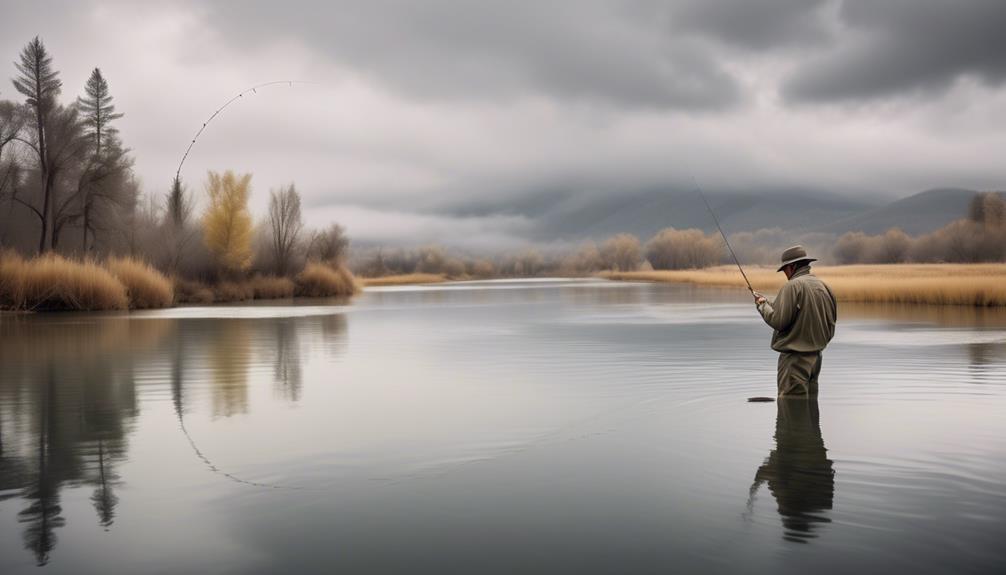
When fly fishing on an overcast day, you may find that fish are more active and receptive to your flies due to the diffused light conditions. This is an ideal time to practice various fly fishing techniques that can yield great results.
One effective technique to try on overcast days is nymphing. Nymphs imitate immature aquatic insects, and they're a favorite food source for fish. Using a strike indicator with a nymph can help you detect subtle takes, increasing your chances of hooking a fish.
Choosing the right flies is crucial for overcast day fly fishing. Cloudy weather often means that insects are more active, and the fish are accustomed to feeding on them. Therefore, carrying a selection of wet flies, streamers, and emergers can be beneficial. Wet flies can mimic insects that have fallen into the water, while streamers can imitate small fish or other larger food sources. Emergers are effective when fish are feeding just below the surface, as they imitate insects emerging from their nymphal shucks.
On overcast days, the reduced sunlight can make fish less wary of predators, allowing for more aggressive feeding behavior. By employing the right fly fishing techniques and selecting the appropriate flies, you can take advantage of these conditions and have a successful day on the water.
Peak Insect Hatch Seasons
During peak insect hatch seasons, your success in fly fishing can greatly depend on your ability to match the hatch with the appropriate fly patterns. This is the time when various insect species emerge in large numbers, triggering a feeding frenzy among fish. To make the most of this prime time for fly fishing, consider the following key factors:
- Best Locations: Research the best locations for insect hatches in your area. Rivers, streams, and lakes with healthy insect populations will provide ample opportunities for successful fly fishing. Look for areas with diverse aquatic insect life to increase your chances of encountering a hatch.
- Fly Selection: Understanding the insect species that are hatching is crucial for selecting the right fly patterns. Matching the size, color, and behavior of the natural insects will significantly improve your chances of a successful day on the water. Carry a variety of imitative fly patterns to mimic the insects that are hatching, including dry flies, nymphs, and emergers.
- Observation: Pay close attention to the water and surrounding vegetation to identify the specific insects that are hatching. By observing the behavior of the fish and the insects, you can better determine which fly patterns to use.
- Adaptability: Be prepared to adapt quickly to changing conditions. Insect hatches can be unpredictable, so having a diverse selection of fly patterns and being willing to switch tactics as the hatch progresses will increase your chances of success.
Frequently Asked Questions
What Are the Best Techniques for Fly Fishing During Each Season?
For each season, adjust your fly fishing techniques. In spring, focus on nymphs and emergers. In summer, use dry flies and streamers. Fall calls for streamers and nymphs. Winter requires slow retrieves and smaller flies.
Are There Any Specific Fly Patterns That Work Best During Early Morning or Late Afternoon Fly Fishing?
For early morning fly fishing, certain fly patterns like mayflies and caddisflies are quite effective. In the late afternoon, using patterns like stoneflies and grasshoppers can bring you great success in catching fish.
How Does Weather, Such as Rain or Wind, Affect Fly Fishing During Different Seasons?
When it comes to fly fishing, weather plays a big role in different seasons. Temperature impacts fish activity and feeding patterns, while barometric pressure affects their behavior. Rain can increase water flow, and wind can make casting challenging.
Are There Any Specific Locations or Bodies of Water That Are Ideal for Fly Fishing During Each Season?
For the best locations and techniques during each season, consider the seasonal fly patterns and how weather impacts fishing. Look for ideal spots and adjust your approach to maximize your fly fishing experience.
What Are Some Common Mistakes That Beginners Make When Fly Fishing During Peak Insect Hatch Seasons?
When fly fishing during peak insect hatch seasons, beginners often make common mistakes. It's crucial to have the proper gear and master casting techniques. Reading water is essential for success. Avoid these errors for a better experience.
Conclusion
So, whether it's the spring, summer, fall, or winter, there's always a prime season for fly fishing.
Whether you prefer early morning or late afternoon, sunny days or overcast ones, there's always an opportunity to reel in the big one.
Just remember to pay attention to the peak insect hatch seasons for the best chance at a successful fly fishing experience.
Happy fishing!
